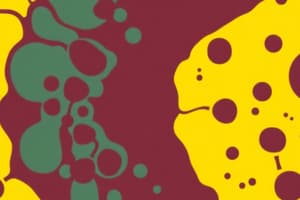Podcast
Questions and Answers
What is the primary consequence of cellular swelling during early stages of injury?
What is the primary consequence of cellular swelling during early stages of injury?
- Inability to maintain ionic and fluid homeostasis (correct)
- Loss of membrane integrity
- Nuclear dissolution without membrane loss
- Inflammatory response activation
Which statement accurately describes necrosis?
Which statement accurately describes necrosis?
- It is characterized by nuclear shrinkage and chromatin condensation.
- It is always a physiological process.
- It involves the activation of apoptosis mechanisms.
- It results in the leakage of cellular contents into the extracellular space. (correct)
What change occurs during fatty change in cells?
What change occurs during fatty change in cells?
- Disintegration of the cell membrane
- Appearance of large lipid vacuoles in the cytoplasm (correct)
- Increased activity of lysosomal enzymes
- Decrease in mitochondrial function
Which mechanism primarily leads to irreversible cell injury?
Which mechanism primarily leads to irreversible cell injury?
Which of the following is NOT a cause of cell damage?
Which of the following is NOT a cause of cell damage?
Which characteristic is indicative of apoptosis as opposed to necrosis?
Which characteristic is indicative of apoptosis as opposed to necrosis?
What is the initial physiological change observed in reversible cell injury?
What is the initial physiological change observed in reversible cell injury?
What pathological process occurs with necrosis that is not a feature of apoptosis?
What pathological process occurs with necrosis that is not a feature of apoptosis?
Which factor is most likely to contribute to the hypertrophy of the endoplasmic reticulum in response to injury?
Which factor is most likely to contribute to the hypertrophy of the endoplasmic reticulum in response to injury?
What type of cell death always results from severe damage to cellular membranes?
What type of cell death always results from severe damage to cellular membranes?
What is the primary consequence of reduced activity of plasma membrane ATP-dependent sodium pumps?
What is the primary consequence of reduced activity of plasma membrane ATP-dependent sodium pumps?
What triggers the activation of enzymes due to increased cytosolic Ca2+ concentration?
What triggers the activation of enzymes due to increased cytosolic Ca2+ concentration?
What is a key function of glutathione (GSH) peroxidases in cellular processes?
What is a key function of glutathione (GSH) peroxidases in cellular processes?
Which of the following statements best describes reactive oxygen species (ROS)?
Which of the following statements best describes reactive oxygen species (ROS)?
Which enzyme is significantly involved in accelerating the decay of superoxide free radicals?
Which enzyme is significantly involved in accelerating the decay of superoxide free radicals?
What is the expected outcome from the failure of oxidative phosphorylation?
What is the expected outcome from the failure of oxidative phosphorylation?
What effect does the intracellular accumulation of sodium have on cells?
What effect does the intracellular accumulation of sodium have on cells?
What cellular change is associated with necrosis?
What cellular change is associated with necrosis?
Which enzyme class is primarily responsible for causing membrane damage when activated by increased intracellular calcium?
Which enzyme class is primarily responsible for causing membrane damage when activated by increased intracellular calcium?
Which pathological process can lead to fatty change in cells?
Which pathological process can lead to fatty change in cells?
What is the primary characteristic of fatty change in cells?
What is the primary characteristic of fatty change in cells?
Which of the following alterations is NOT characteristic of necrotic cells?
Which of the following alterations is NOT characteristic of necrotic cells?
In the context of cell injury, what is the fate of necrotic cells?
In the context of cell injury, what is the fate of necrotic cells?
What typically causes necrosis in cells?
What typically causes necrosis in cells?
Which of the following mechanisms best describes the typical cellular response to injurious stimuli?
Which of the following mechanisms best describes the typical cellular response to injurious stimuli?
What is a possible consequence of biochemical alterations due to cellular injury?
What is a possible consequence of biochemical alterations due to cellular injury?
Which type of nuclear change is characterized by the fragmentation of chromatin?
Which type of nuclear change is characterized by the fragmentation of chromatin?
What tissue type can generally withstand complete ischemia for several hours without irreversible injury?
What tissue type can generally withstand complete ischemia for several hours without irreversible injury?
Which of the following best describes the role of lysosomal enzymes in necrosis?
Which of the following best describes the role of lysosomal enzymes in necrosis?
Which condition is least likely to occur as a result of necrosis?
Which condition is least likely to occur as a result of necrosis?
Flashcards
Cell Damage
Cell Damage
Occurs when cells are unable to adapt to stress, are exposed to harmful agents, or contain intrinsic abnormalities.
Reversible Cell Injury
Reversible Cell Injury
Early or mild cell damage; changes are reversible if the harmful stimulus stops.
Cell Death (Necrosis)
Cell Death (Necrosis)
Irreversible cell injury; severe membrane damage leads to enzyme leakage, digestion, and cell breakdown.
Cell Death (Apoptosis)
Cell Death (Apoptosis)
Signup and view all the flashcards
Necrosis Cause
Necrosis Cause
Signup and view all the flashcards
Apoptosis Cause
Apoptosis Cause
Signup and view all the flashcards
Hypoxia
Hypoxia
Signup and view all the flashcards
Cellular Swelling
Cellular Swelling
Signup and view all the flashcards
Fatty Change
Fatty Change
Signup and view all the flashcards
Causes of cell damage
Causes of cell damage
Signup and view all the flashcards
Plasma membrane sodium pump failure
Plasma membrane sodium pump failure
Signup and view all the flashcards
ATP-Dependent Calcium Pumps
ATP-Dependent Calcium Pumps
Signup and view all the flashcards
Oxidative Phosphorylation Failure
Oxidative Phosphorylation Failure
Signup and view all the flashcards
Reactive Oxygen Species (ROS)
Reactive Oxygen Species (ROS)
Signup and view all the flashcards
Cytosolic Calcium Increase
Cytosolic Calcium Increase
Signup and view all the flashcards
Free Radicals
Free Radicals
Signup and view all the flashcards
Superoxide Dismutases (SOD)
Superoxide Dismutases (SOD)
Signup and view all the flashcards
Glutathione Peroxidases
Glutathione Peroxidases
Signup and view all the flashcards
Decreased Phospholipid Synthesis
Decreased Phospholipid Synthesis
Signup and view all the flashcards
Mitochondrial Damage
Mitochondrial Damage
Signup and view all the flashcards
Hydropic Change
Hydropic Change
Signup and view all the flashcards
Vacuolar Degeneration
Vacuolar Degeneration
Signup and view all the flashcards
Blebbing
Blebbing
Signup and view all the flashcards
Blunting
Blunting
Signup and view all the flashcards
ER Dilation
ER Dilation
Signup and view all the flashcards
Chromatin Clumping
Chromatin Clumping
Signup and view all the flashcards
Necrosis
Necrosis
Signup and view all the flashcards
Karyolysis
Karyolysis
Signup and view all the flashcards
Pyknosis
Pyknosis
Signup and view all the flashcards
Study Notes
Local Reactions of the Organism
- Cell damage occurs when cells are stressed severely, unable to adapt, or exposed to damaging agents/intrinsic abnormalities
- Reversible cell injury—early/mild injury; functional & morphologic changes are reversible if the damaging stimulus is removed
- Cell death—continued damage; irreversible; two types: necrosis & apoptosis, which differ in mechanisms, morphology, and roles in disease and physiology
- Necrosis occurs when damage to membranes is severe; enzymes leak out of lysosomes, enter cytoplasm, digest the cell, resulting in necrosis.
- Cellular contents leak into extracellular space, causing an inflammatory reaction.
- Necrosis is always a pathologic process
- Apoptosis—when a cell lacks growth factors or has damaged DNA/proteins beyond repair; the cell kills itself.
- Apoptosis is characterized by nuclear dissolution, but without loss of membrane integrity, not always caused by pathologic cell damage
- Apoptosis does not elicit inflammation.
Causes of Cell Damage
- Oxygen deprivation (hypoxia)
- Chemical agents (e.g., CO, asbestos)
- Infectious agents (e.g., fungi, bacteria)
- Immunologic reactions (e.g., autoimmune reactions)
- Nutritional imbalances
- Physical agents (e.g., shock, temperature)
- Aging
Types of Cell Damage
- Reversible & irreversible cell damage
- The graph shows stages of reversible & irreversible cell injury, from cell function to stages of death, indicating the severity of changes as well.
Reversible Injury
- Two key changes: cellular swelling & fatty change
- Cellular swelling—result of pump failure; inability to maintain ionic/fluid homeostasis.
- Fatty change—occurs in hypoxic injury and other toxic/metabolic injuries; small or large lipid vacuoles in the cytoplasm appear
- Injurious insults induce changes in cellular organelles (e.g., endoplasmic reticulum, or ER)
- This may be an adaptive response with important functional consequences.
Cellular Swelling
- First manifestation of injury to cells
- Causes pallor (compression of capillaries), increased turgor, and increase in organ weight
- Clear vacuoles within cytoplasm (distended & pinched-off segments of endoplasmic reticulum (ER))
- Also called hydropic change or vacuolar degeneration
Fatty Change
- Manifested by appearance of lipids in the cytoplasm.
- Primarily found in fat-metabolizing cells (e.g., hepatocytes, myocardial cells), and is reversible
- Plasma membrane alterations (blebbing, blunting, distortion of microvilli)
- Endoplasmic reticulum (ER) dilation, ribosome detachment, and polysome dissociation
- Chromatin clumping noted.
Irreversible Cell Damage
- Necrosis—loss of membrane integrity & leakage of cellular contents, dissolution of injured cells.
- Enzymes from dying cells & leukocytes digest the cells.
- Associated with inflammation
Cytoplasmic Changes (necrosis)
- Necrotic cells show increased eosinophilia
- Nuclear changes occur; one of three patterns (due to DNA/chromatin breakdown): karyolysis, pyknosis, or karyorrhexis
- Fates of necrotic cells may persist, be digested, or disappear
Mechanism of Cell Damage
- Cellular response to injurious stimuli depends on injury type, duration, severity, status
- Consequences depend on the injured cell's type, adaptability, & genetic makeup.
- Cell injury results from abnormalities in several essential cellular components
- Multiple biochemical alterations can be triggered by a single injurious insult
- Examples: muscle tissues show different tolerance times to ischemia.
Mitochondrial Damage and Dysfunction
- Failure of oxidative phosphorylation leads to progressive ATP depletion
- Abnormal oxidative phos., leads to reactive oxygen species (ROS) formation
Influx of Calcium
- Cytosolic free calcium normally maintained at low levels by calcium transporters (ATP-dependent)
- Ischemia & certain toxins increase cytosolic calcium
- Increased cytosolic calcium activates enzymes: phospholipases & proteases
- These enzymes damage membranes and cytoskeletal proteins.
Oxidative Stress
- Free radicals (single unpaired electron)
- Reactive oxygen species (ROS)
- Role in cell injury.
ROS (Reactive Oxygen Species) in Inflammation & Host Defense
- Produced in phagocytic leukocytes (e.g., neutrophils, macrophages).
- Used to destroy ingested microbes/substances.
- NO (nitric oxide) is another reactive free radical.
- Protective mechanisms exist to remove ROS: superoxide dismutases (SODs) & glutathione peroxidases (GSH).
Defective Membrane Permeability
- Decreased phospholipid synthesis (due to low ATP levels)
- Increased phospholipid breakdown
- ROS (damaging effect)
- Cytoskeletal abnormalities
- Disturbances in membrane architecture, motility, and signaling resulting from changes.
- Lipid breakdown products
3 Main reactions that cause cell damage
- Lipid peroxidation of membranes
- Changes/Cross-linking in proteins
- DNA damage
Damage to DNA & Proteins
- Cells repair DNA damage, but severe damage triggers apoptosis
Studying That Suits You
Use AI to generate personalized quizzes and flashcards to suit your learning preferences.




